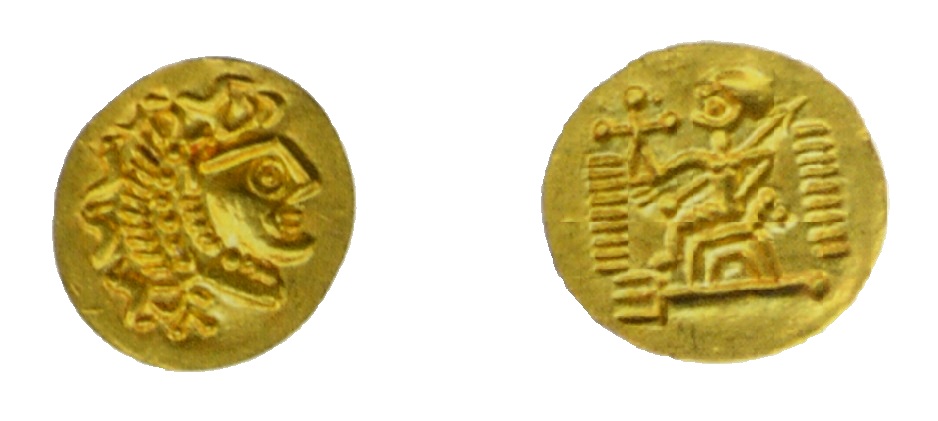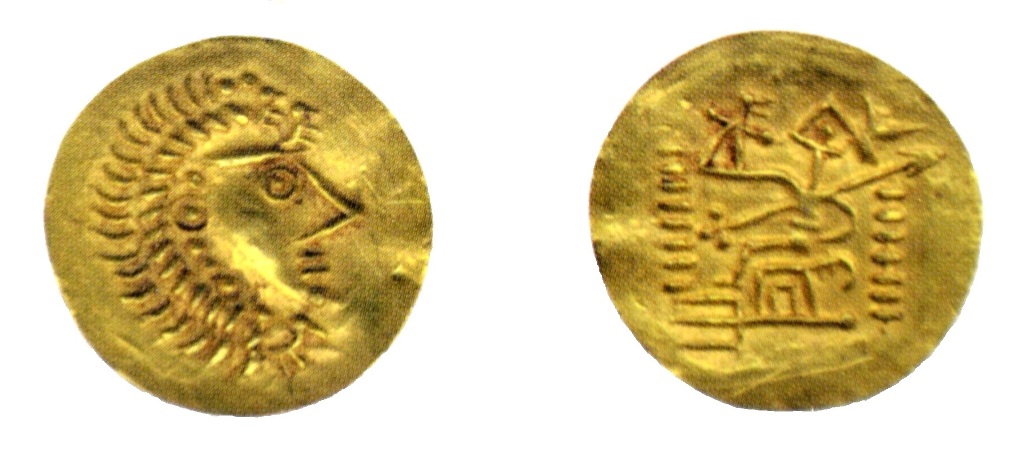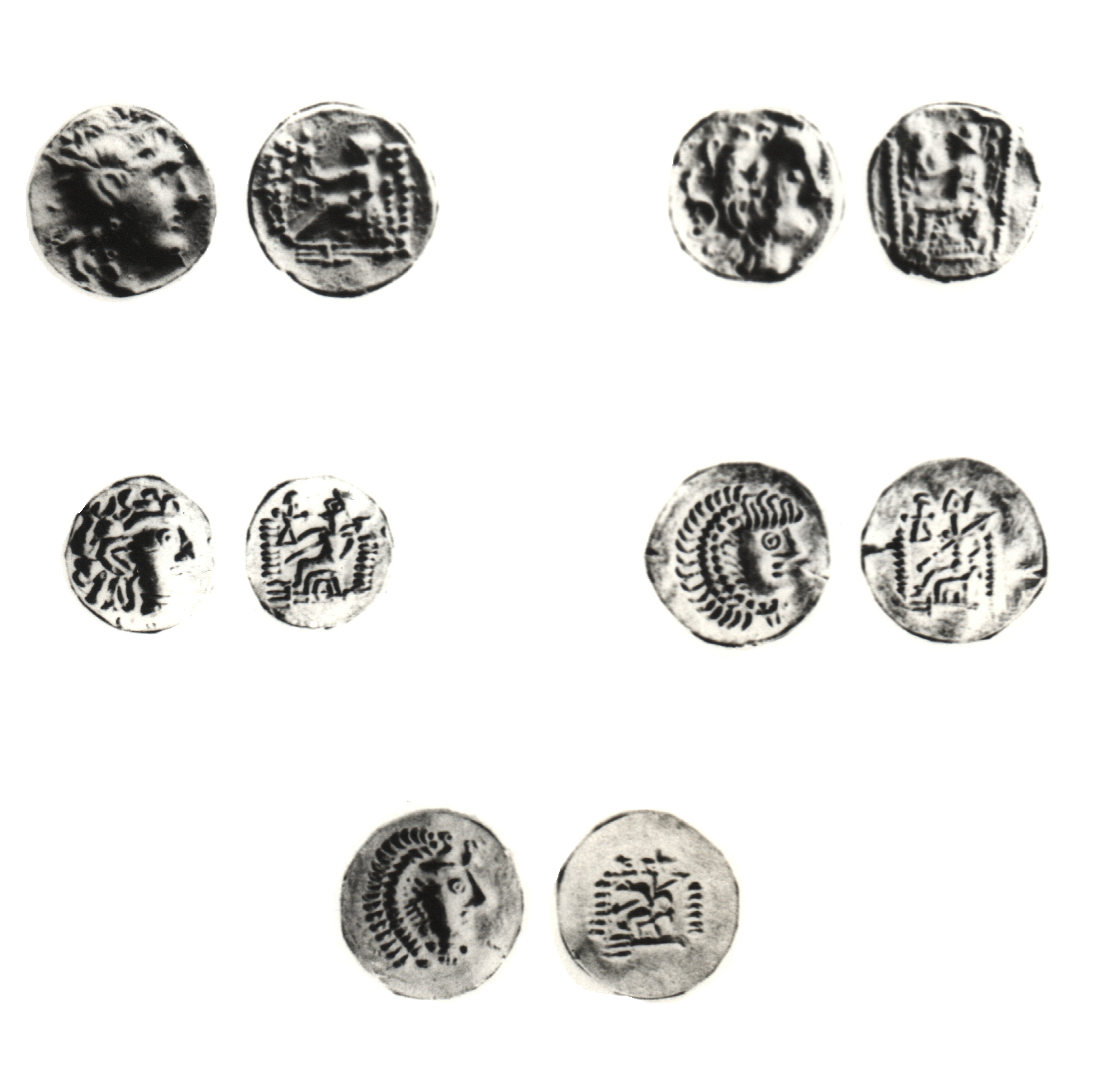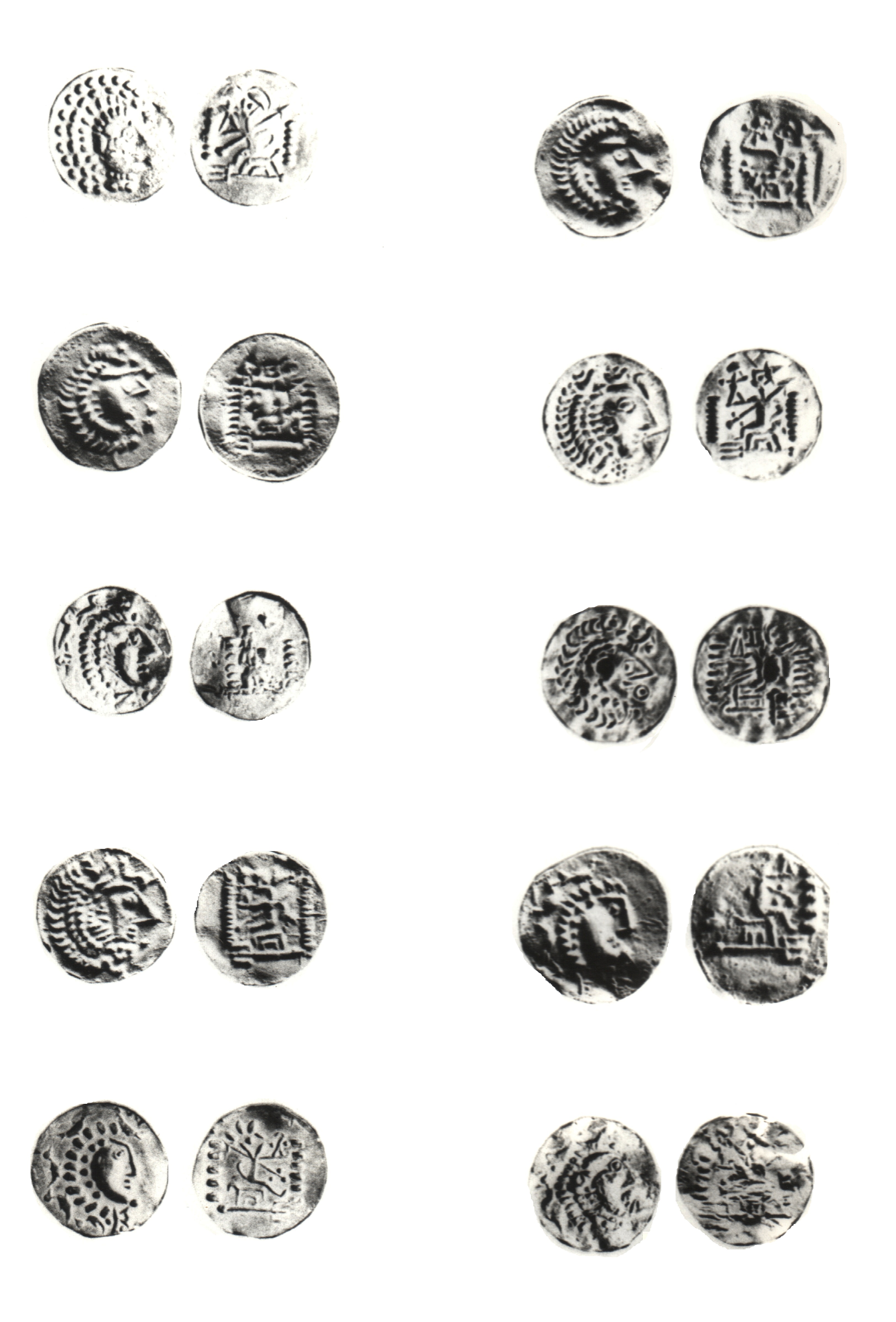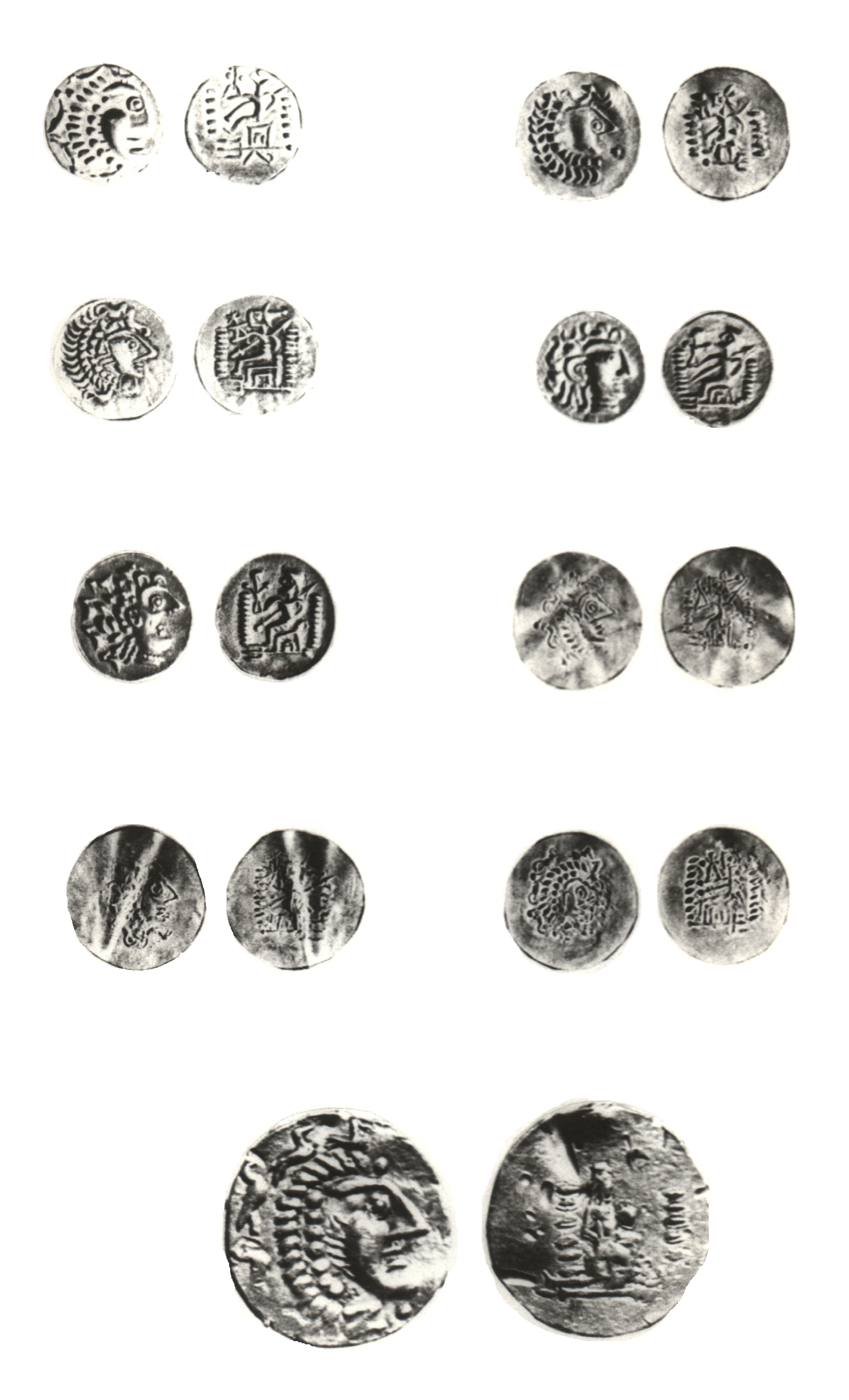Georgian imitations to Lysimachus’ type staters
Type: Georgian imitations to Lysimachus’ type staters
Description, picture:
Gold.
The weights range from 1,1 to 7,9 gr. d=18-24 mm.
Obverse: Non-naturalistic head, right; radiant hair-style sometimes ornamented with bird-effigies.
Reverse: Schematic Athena enthroned, left/right, holding Nike, trident below.
Gold.
The weights range from 1,1 to 7,9 gr. d=18-24 mm.
Obverse: Non-naturalistic head, right; radiant hair-style sometimes ornamented with bird-effigies.
Reverse: Schematic Athena enthroned, left/right, holding Nike, trident below.
Scholarly commentary:
Alexander the Great’s conquests had huge impact on coinage as well as on every aspect of life of the Antique states. Money system of this unique person became dominant almost in the whole world of those times. After the death of Alexander of Macedon, Lysimachus, one of his distinguished military commanders (the Diadochi), the king of Thrace and Macedon, struck coins with the depiction of Alexander and they gained great international recognition. The coins of Alexander and Lysimachus became so popular in the Ancient world that minting of the coins of both types with their names on them continued some two or three centuries after the death of these monarchs on the different territories by different juridical organs (or persons).
Termination of the emission of Colchian money (“Colchian tetri”) is linked with the massive influx of the staters of Alexander the Great. Moreover, the coins struck later on the territory of Ancient Colchis and Iberia typologically are connected to the coins struck with the name of Alexander and Lysimachus, thus they are imitations. Aka stater is the earliest one (Obv. Diademed head of Alexander the Great, right, wearing horn of Ammon. Rev. Athena Pallas enthroned, left, holding Nike in an open right hand and resting left hand on the arm of the throne. Shield on the backside of the throne. Trident below, dolphins on both sides of trident. The Greek inscription behind the composition – ΒΑΣΙΛΕΩΣ, in front –ΑΚΟΥ). Aka stater is the exact copy of the gold coins struck with the name of Lysimachus which were issued by Byzantium after 195 B.C. The emblem of this city – trident with two dolphins on the handle is depicted on the coins struck in Byzantium. Aka stater is dated to the times after 195 B.C., the 80s of the 2nd c. B.C.
The weight of the coin is 8,45 gr., pure gold. Only two specimens are known.
Stylistically, technically and artistically the coin is no less than its prototype.
The topography of the coin findings proves their local, Colchian origin – they are discovered in Trabzon/Trapezus (1865), on the territory once being Colchian and in Kinchkha, Khoni district, Georgia (1946).
Aka stater is followed by the series of locally minted gold imitations – the Georgian imitations to Alexander and Lysimachus’ type staters.
These coins are known in scientific literature since the 60s of the 19th c. The topography of the findings and the stylistic-material data prove their Georgian origin. Although some aspects concerning the coins are not still confirmed – it is totally unclear who mints them, a state or some other institution, or a private person, whose competence is their emission, etc.
The earliest sample from the Georgian imitations to Alexander and Lysimachus’ type staters is the one discovered in the village Reke, Zugdidi district, Georgia, which is very close to the original, or perhaps, even to Aka stater. This gives us opportunity to place it chronologically close to Aka stater. The supposed date of its issue is fixed in the 60-50s of the 2nd c. B.C. The coin is 7,78 gr. gold of high standard.
Gradually, images of the Georgian imitations to Lysimachus’ type staters became rough, schematic and very distant from the originals. Also, the fineness of the coins becomes worse and the weight decreases (the weights range from 1,1 to 7,9 gr.).
The Georgian imitations to Lysimachus’ type staters are discovered with other well-dated coins and also, in well-dated burials. Basing on this information, their emission is supposed to fit the period after the 80s of the 2nd c. B.C. till the last quarter of the 1st c. B.C.
As for the Georgian imitations to Alexander’s type staters (Obv. Non-naturalistic head, right. Rev. Bull-headed, or ram-headed schematic Nike, facing), the earliest ones of them have not been preserved till today. According to the discovered ones, we can conclude that the weight of these imitations is also decreasing gradually (the weights range from 1,6 to 3,7 gr.) and the fineness becomes worse. Finally they became silver coins.
Chronological length of the emission of the imitations to Alexander’s type staters is 1st c. B.C.-1st c. A.D. Certainly, it concerns just the ones which are preserved till today.
Since the Georgian imitations to Lysimachus’ type staters had been discovered mostly in West Georgia, the opinion was expressed about their Colchian origin. These coins were named as Colchian staters (on the contrary, the topography of discovery seemed to show that the Georgian imitations to Alexander’s type staters were of East Georgian origin. So, they were called Iberian staters). Although nowadays it is difficult to share this opinion. On the one hand, the category of the imitations cannot be called a stater and on the other hand, new findings changed the map of their discovery – 18 of them are found in West Georgia and 8 – in East Georgia.
So, the imitations of above-mentioned category are common for Georgia (as well as the imitations to the staters struck with the name of Alexander – 14 samples are discovered in East Georgia, 19 samples – in Argveti (extreme eastern province of West Georgia), which sometimes was politically under the Iberian kingdom, i.e. 33 samples in all. Their number in West Georgia reaches 26 samples). It would be better if we use the term: the Georgian imitations to Lysimachus’ type staters (analogically – the Georgian imitations to Alexander’s type staters).
As far as the reasons of genesis and function of the so-called “Barbarian” imitations are concerned, we should mention that there is no disagreement about them in scientific circles. It is thoroughly admitted that when the influx of very widespread and popular coins is decreasing on the market of a country, the imitations fill this “vacuum”. The other question is – who is the issuer of them – a state or private persons, who provide the market with non-equivalent surrogates. This is a very difficult problem. There is also opinion that the Georgian imitations to Alexander and Lysimachus’ type staters were struck in Colchis. This opinion together with other arguments is also supported by the fact that logical issuer of the money is supposed to be in West Georgia – there is long-term economic crisis in Colchis from the 2nd c. B.C. which is connected with the social reorganization of the country and accordingly, the debased money would have been needed. This process did not take place in Iberia, so, the coins should have been struck in Colchis. Supposedly, the Colchian skeptukhoi/dukes minted them. It does not mean that the money did not spread in Iberia, on the contrary, some samples perhaps, became the prototypes of the underground mint.
And finally, do the imitations have the function of money? The absolute majority of the scientists give positive answer to this question. Comparatively good art, high weight and fineness of some samples, and also, the fact that the imitations are discovered in the hoards with the so-called “legal” coins, indicate to this. So, economic nature of the imitations is beyond dispute.
Alexander the Great’s conquests had huge impact on coinage as well as on every aspect of life of the Antique states. Money system of this unique person became dominant almost in the whole world of those times. After the death of Alexander of Macedon, Lysimachus, one of his distinguished military commanders (the Diadochi), the king of Thrace and Macedon, struck coins with the depiction of Alexander and they gained great international recognition. The coins of Alexander and Lysimachus became so popular in the Ancient world that minting of the coins of both types with their names on them continued some two or three centuries after the death of these monarchs on the different territories by different juridical organs (or persons).
Termination of the emission of Colchian money (“Colchian tetri”) is linked with the massive influx of the staters of Alexander the Great. Moreover, the coins struck later on the territory of Ancient Colchis and Iberia typologically are connected to the coins struck with the name of Alexander and Lysimachus, thus they are imitations. Aka stater is the earliest one (Obv. Diademed head of Alexander the Great, right, wearing horn of Ammon. Rev. Athena Pallas enthroned, left, holding Nike in an open right hand and resting left hand on the arm of the throne. Shield on the backside of the throne. Trident below, dolphins on both sides of trident. The Greek inscription behind the composition – ΒΑΣΙΛΕΩΣ, in front –ΑΚΟΥ). Aka stater is the exact copy of the gold coins struck with the name of Lysimachus which were issued by Byzantium after 195 B.C. The emblem of this city – trident with two dolphins on the handle is depicted on the coins struck in Byzantium. Aka stater is dated to the times after 195 B.C., the 80s of the 2nd c. B.C.
The weight of the coin is 8,45 gr., pure gold. Only two specimens are known.
Stylistically, technically and artistically the coin is no less than its prototype.
The topography of the coin findings proves their local, Colchian origin – they are discovered in Trabzon/Trapezus (1865), on the territory once being Colchian and in Kinchkha, Khoni district, Georgia (1946).
Aka stater is followed by the series of locally minted gold imitations – the Georgian imitations to Alexander and Lysimachus’ type staters.
These coins are known in scientific literature since the 60s of the 19th c. The topography of the findings and the stylistic-material data prove their Georgian origin. Although some aspects concerning the coins are not still confirmed – it is totally unclear who mints them, a state or some other institution, or a private person, whose competence is their emission, etc.
The earliest sample from the Georgian imitations to Alexander and Lysimachus’ type staters is the one discovered in the village Reke, Zugdidi district, Georgia, which is very close to the original, or perhaps, even to Aka stater. This gives us opportunity to place it chronologically close to Aka stater. The supposed date of its issue is fixed in the 60-50s of the 2nd c. B.C. The coin is 7,78 gr. gold of high standard.
Gradually, images of the Georgian imitations to Lysimachus’ type staters became rough, schematic and very distant from the originals. Also, the fineness of the coins becomes worse and the weight decreases (the weights range from 1,1 to 7,9 gr.).
The Georgian imitations to Lysimachus’ type staters are discovered with other well-dated coins and also, in well-dated burials. Basing on this information, their emission is supposed to fit the period after the 80s of the 2nd c. B.C. till the last quarter of the 1st c. B.C.
As for the Georgian imitations to Alexander’s type staters (Obv. Non-naturalistic head, right. Rev. Bull-headed, or ram-headed schematic Nike, facing), the earliest ones of them have not been preserved till today. According to the discovered ones, we can conclude that the weight of these imitations is also decreasing gradually (the weights range from 1,6 to 3,7 gr.) and the fineness becomes worse. Finally they became silver coins.
Chronological length of the emission of the imitations to Alexander’s type staters is 1st c. B.C.-1st c. A.D. Certainly, it concerns just the ones which are preserved till today.
Since the Georgian imitations to Lysimachus’ type staters had been discovered mostly in West Georgia, the opinion was expressed about their Colchian origin. These coins were named as Colchian staters (on the contrary, the topography of discovery seemed to show that the Georgian imitations to Alexander’s type staters were of East Georgian origin. So, they were called Iberian staters). Although nowadays it is difficult to share this opinion. On the one hand, the category of the imitations cannot be called a stater and on the other hand, new findings changed the map of their discovery – 18 of them are found in West Georgia and 8 – in East Georgia.
So, the imitations of above-mentioned category are common for Georgia (as well as the imitations to the staters struck with the name of Alexander – 14 samples are discovered in East Georgia, 19 samples – in Argveti (extreme eastern province of West Georgia), which sometimes was politically under the Iberian kingdom, i.e. 33 samples in all. Their number in West Georgia reaches 26 samples). It would be better if we use the term: the Georgian imitations to Lysimachus’ type staters (analogically – the Georgian imitations to Alexander’s type staters).
As far as the reasons of genesis and function of the so-called “Barbarian” imitations are concerned, we should mention that there is no disagreement about them in scientific circles. It is thoroughly admitted that when the influx of very widespread and popular coins is decreasing on the market of a country, the imitations fill this “vacuum”. The other question is – who is the issuer of them – a state or private persons, who provide the market with non-equivalent surrogates. This is a very difficult problem. There is also opinion that the Georgian imitations to Alexander and Lysimachus’ type staters were struck in Colchis. This opinion together with other arguments is also supported by the fact that logical issuer of the money is supposed to be in West Georgia – there is long-term economic crisis in Colchis from the 2nd c. B.C. which is connected with the social reorganization of the country and accordingly, the debased money would have been needed. This process did not take place in Iberia, so, the coins should have been struck in Colchis. Supposedly, the Colchian skeptukhoi/dukes minted them. It does not mean that the money did not spread in Iberia, on the contrary, some samples perhaps, became the prototypes of the underground mint.
And finally, do the imitations have the function of money? The absolute majority of the scientists give positive answer to this question. Comparatively good art, high weight and fineness of some samples, and also, the fact that the imitations are discovered in the hoards with the so-called “legal” coins, indicate to this. So, economic nature of the imitations is beyond dispute.
Mint: Unknown.
Nominal: Gold. 1,1gr.-7,9 gr.
Date: After the 80s of the 2nd c. B.C.-the last quarter of the 1st c. B.C.
Collection: Simon Janashia Museum of Georgia – more than 20 specimens, GF. (Fund of Treasury, Numismatic Collection, Simon Janashia Museum of Georgia) №1680, GF. №3067, GF. №4871, GF. №5253, GF. №10073, GF. №11413, GF. №11814, GF. №11921, GF. №15558, GF. №№16873-16875, GF. №18803; QF. (Main Fund of the Georgian Coins, Numismatic Collection, Simon Janashia Museum of Georgia) №№49-51, QF. №1578, QF. №1699, QF. №1700, QF. №3316, QF. №3810, QF. №3811, QF. №4028.
Bibliography:
G. Dundua. Coins Struck with the Name of Alexander and Lysimachus Spread in Georgia. “Matsne”. Series of History, Archaeology, Ethnology and Art History. №1. Tbilisi. 1973 (in Georg.); Money in Georgia (Georg. and Engl. parallel texts) (T. Dundua, N. Javakhishvili and A. Eristavi as co-authors). Tb. 2003 (2nd Edition); Georgian Numismatics. I. Tb. 2006 (T. Dundua as co-author) (in Georg.).
D. Kapanadze. Georgian Numismatics. Tbilisi. 1969 (in Georg.).
Г. Ф. Дундуа. Нумизматика античной Грузии. Тб. 1987.
А. Н. Зограф. Античные золотые монеты Кавказа. Известия Государственной Академии Истории Материальной Культуры (ИГАИМК). вып. 110. 1935; Распространение находок античных монет на Кавказе. Труды Отдела Нумизматики Государственного Эрмитажа (ТОНГЭ). т. I. Л. 1945.
Д. Г. Капанадзе. Грузинская нумизматика. М. 1955.
Е. А. Пахомов. Монеты Грузии.ч. I. СПб. 1910; Монеты Грузии. ч. I-II. Тб. 1970.
G. Dundua. Coins Struck with the Name of Alexander and Lysimachus Spread in Georgia. “Matsne”. Series of History, Archaeology, Ethnology and Art History. №1. Tbilisi. 1973 (in Georg.); Money in Georgia (Georg. and Engl. parallel texts) (T. Dundua, N. Javakhishvili and A. Eristavi as co-authors). Tb. 2003 (2nd Edition); Georgian Numismatics. I. Tb. 2006 (T. Dundua as co-author) (in Georg.).
D. Kapanadze. Georgian Numismatics. Tbilisi. 1969 (in Georg.).
Г. Ф. Дундуа. Нумизматика античной Грузии. Тб. 1987.
А. Н. Зограф. Античные золотые монеты Кавказа. Известия Государственной Академии Истории Материальной Культуры (ИГАИМК). вып. 110. 1935; Распространение находок античных монет на Кавказе. Труды Отдела Нумизматики Государственного Эрмитажа (ТОНГЭ). т. I. Л. 1945.
Д. Г. Капанадзе. Грузинская нумизматика. М. 1955.
Е. А. Пахомов. Монеты Грузии.ч. I. СПб. 1910; Монеты Грузии. ч. I-II. Тб. 1970.
Imported coins found in Georgia:
Coins struck with the name of Alexander of Macedon
a) Staters struck with the name of Alexander of Macedon.
1. Gold coins struck with the name of Alexander of Macedon are discovered in Svaneti (in different places) – 367 pieces (majority of them is discovered in the hoards), Reke (Zugdidi district) – 2, Vani – 2, Pichvnari, Lentekhi, Phartskhanakanevi (Tskaltubo district), Gulripshi district, Chiora (Oni district) and Mtskheta (East Georgia) – 1 respectively. Obv. Athena with long hair in Corinthian helmet, right. In some cases, coiled snake is depicted on the helmet. Also, in some cases, the goddess has beads on her neck and earrings on the ears. Rev. Winged Nike in a long chiton, standing left. Crown in the right hand and stylus in the left. The Greek inscription is behind it on the early samples – ΑΛΕΞΑΝΔΡΟΥ. Later ones have the inscription – ΒΑΣΙΛΕΩΣ in front, and ΑΛΕΞΑΝΔΡΟΥ behind. In addition, different monograms and symbols are placed on the area of the coin and they give us information about the mint. The average weight – 8,50 gr., pure gold.
b) Silver coins struck with the name of Alexander of Macedon (different nominals).
2. From Alexander’s silver coins discovered on the territory of Georgia two are drachms and one is tetradrachm. Topography of the findings is the following: Kutaisi, surroundings of Kvirila river and Kachreti (Gurjaani district, East Georgia). Obv. Heracles in the lion’s skin, right. He has Alexander’s features. Rev. Zeus enthroned, left. Eagle on his right hand. The Greek inscription behind the depiction – ΑΛΕΞΑΝΔΡΟΥ. Different monograms and symbols on the area of the coin.
Gold staters of Philip III of Macedon (323-316 B.C.).
3. Two coins of Philip III are discovered on the territory of Georgia, one is an accidental finding in Agudzera (Abkhazia), on the seashore and the other one was found in Vani, during archaeological excavations. Gold coin of Philip III of Macedon is an exact copy of Alexander’s stater. The difference is just in a legend: ΦΙΛΙΠΠΟΥ.
Staters and silver coins struck with the name of Lysimachus (king of Thrace and Macedon in 306-282 B.C.) (They are of the same type).
4. Six staters struck with the name of Lysimachus are found on the territory of Georgia. Two of them are discovered in Svaneti, two – in Vani, one – in Eki (Senaki district) and also one – in Gulripshi. One of the two silver coins is discovered in Vani and the other one – in Makriala (part of Batumi region earlier, now in Turkey). Obv. Diademed head of Alexander the Great, right. Rev. Athena Pallas enthroned, left, holding Goddess Nike in the right open hand, resting on spear and shield by the left. The Greek inscription behind the figure – ΒΑΣΙΛΕΩΣ, in front of the figure – ΛΙΣΙΜΑΧΟΥ. Additional symbols and monograms on the reverse of the coin indicating mint of each sample.
Panticapaeum (modern Kerch) staters (the last quarter of the 4th c. B.C.).
5. Panticapaeum staters, about 30-32 pieces, are discovered in Svaneti as a hoard and one in the region of Mingrelia. Obv. Head of bearded satyr with the plush crown, left. Rev. Lion-headed Gryphon, left, wheatear below. The Greek inscription ΠΑΝ – gives us the name of the city.
Syracuse (Sicily), half stater of Hieron II (275/4-216 B.C.).
6. This gold coin was discovered in Vani during archaeological excavations. This is the only case of finding of the coins from the distant Sicily in Georgia. Obv. Head of Persephone, left. Rev. Nike on the phaeton with two horses, right. The Greek legend for the name of Hieron.
Imported gold coins of the 4th -3rd cc. B.C. found in Georgia
Coins struck with the name of Alexander of Macedon
a) Staters struck with the name of Alexander of Macedon.
1. Gold coins struck with the name of Alexander of Macedon are discovered in Svaneti (in different places) – 367 pieces (majority of them is discovered in the hoards), Reke (Zugdidi district) – 2, Vani – 2, Pichvnari, Lentekhi, Phartskhanakanevi (Tskaltubo district), Gulripshi district, Chiora (Oni district) and Mtskheta (East Georgia) – 1 respectively. Obv. Athena with long hair in Corinthian helmet, right. In some cases, coiled snake is depicted on the helmet. Also, in some cases, the goddess has beads on her neck and earrings on the ears. Rev. Winged Nike in a long chiton, standing left. Crown in the right hand and stylus in the left. The Greek inscription is behind it on the early samples – ΑΛΕΞΑΝΔΡΟΥ. Later ones have the inscription – ΒΑΣΙΛΕΩΣ in front, and ΑΛΕΞΑΝΔΡΟΥ behind. In addition, different monograms and symbols are placed on the area of the coin and they give us information about the mint. The average weight – 8,50 gr., pure gold.
b) Silver coins struck with the name of Alexander of Macedon (different nominals).
2. From Alexander’s silver coins discovered on the territory of Georgia two are drachms and one is tetradrachm. Topography of the findings is the following: Kutaisi, surroundings of Kvirila river and Kachreti (Gurjaani district, East Georgia). Obv. Heracles in the lion’s skin, right. He has Alexander’s features. Rev. Zeus enthroned, left. Eagle on his right hand. The Greek inscription behind the depiction – ΑΛΕΞΑΝΔΡΟΥ. Different monograms and symbols on the area of the coin.
Gold staters of Philip III of Macedon (323-316 B.C.).
3. Two coins of Philip III are discovered on the territory of Georgia, one is an accidental finding in Agudzera (Abkhazia), on the seashore and the other one was found in Vani, during archaeological excavations. Gold coin of Philip III of Macedon is an exact copy of Alexander’s stater. The difference is just in a legend: ΦΙΛΙΠΠΟΥ.
Staters and silver coins struck with the name of Lysimachus (king of Thrace and Macedon in 306-282 B.C.) (They are of the same type).
4. Six staters struck with the name of Lysimachus are found on the territory of Georgia. Two of them are discovered in Svaneti, two – in Vani, one – in Eki (Senaki district) and also one – in Gulripshi. One of the two silver coins is discovered in Vani and the other one – in Makriala (part of Batumi region earlier, now in Turkey). Obv. Diademed head of Alexander the Great, right. Rev. Athena Pallas enthroned, left, holding Goddess Nike in the right open hand, resting on spear and shield by the left. The Greek inscription behind the figure – ΒΑΣΙΛΕΩΣ, in front of the figure – ΛΙΣΙΜΑΧΟΥ. Additional symbols and monograms on the reverse of the coin indicating mint of each sample.
Panticapaeum (modern Kerch) staters (the last quarter of the 4th c. B.C.).
5. Panticapaeum staters, about 30-32 pieces, are discovered in Svaneti as a hoard and one in the region of Mingrelia. Obv. Head of bearded satyr with the plush crown, left. Rev. Lion-headed Gryphon, left, wheatear below. The Greek inscription ΠΑΝ – gives us the name of the city.
Syracuse (Sicily), half stater of Hieron II (275/4-216 B.C.).
6. This gold coin was discovered in Vani during archaeological excavations. This is the only case of finding of the coins from the distant Sicily in Georgia. Obv. Head of Persephone, left. Rev. Nike on the phaeton with two horses, right. The Greek legend for the name of Hieron.
